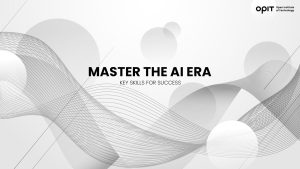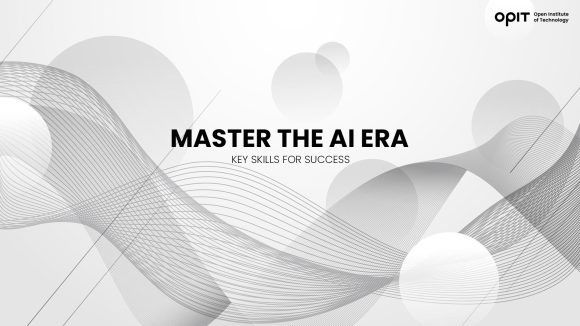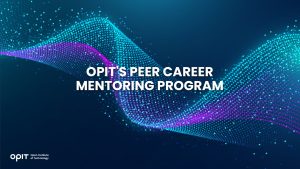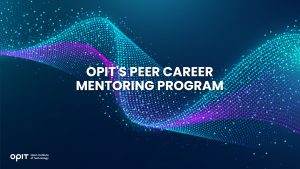

The world is rapidly changing. New technologies such as artificial intelligence (AI) are transforming our lives and work, redefining the definition of “essential office skills.”
So what essential skills do today’s workers need to thrive in a business world undergoing a major digital transformation? It’s a question that Alan Lerner, director at Toptal and lecturer at the Open Institute of Technology (OPIT), addressed in his recent online masterclass.
In a broad overview of the new office landscape, Lerner shares the essential skills leaders need to manage – including artificial intelligence – to keep abreast of trends.
Here are eight essential capabilities business leaders in the AI era need, according to Lerner, which he also detailed in OPIT’s recent Master’s in Digital Business and Innovation webinar.
An Adapting Professional Environment
Lerner started his discussion by quoting naturalist Charles Darwin.
“It is not the strongest of the species that survives, nor the most intelligent that survives. It is the one that is the most adaptable to change.”
The quote serves to highlight the level of change that we are currently seeing in the professional world, said Lerner.
According to the World Economic Forum’s The Future of Jobs Report 2025, over the next five years 22% of the labor market will be affected by structural change – including job creation and destruction – and much of that change will be enabled by new technologies such as AI and robotics. They expect the displacement of 92 million existing jobs and the creation of 170 million new jobs by 2030.
While there will be significant growth in frontline jobs – such as delivery drivers, construction workers, and care workers – the fastest-growing jobs will be tech-related roles, including big data specialists, FinTech engineers, and AI and machine learning specialists, while the greatest decline will be in clerical and secretarial roles. The report also predicts that most workers can anticipate that 39% of their existing skill set will be transformed or outdated in five years.
Lerner also highlighted key findings in the Accenture Life Trends 2025 Report, which explores behaviors and attitudes related to business, technology, and social shifts. The report noted five key trends:
- Cost of Hesitation – People are becoming more wary of the information they receive online.
- The Parent Trap – Parents and governments are increasingly concerned with helping the younger generation shape a safe relationship with digital technology.
- Impatience Economy – People are looking for quick solutions over traditional methods to achieve their health and financial goals.
- The Dignity of Work – Employees desire to feel inspired, to be entrusted with agency, and to achieve a work-life balance.
- Social Rewilding – People seek to disconnect and focus on satisfying activities and meaningful interactions.
These are consumer and employee demands representing opportunities for change in the modern business landscape.
Key Capabilities for the AI Era
Businesses are using a variety of strategies to adapt, though not always strategically. According to McClean & Company’s HR Trends Report 2025, 42% of respondents said they are currently implementing AI solutions, but only 7% have a documented AI implementation strategy.
This approach reflects the newness of the technology, with many still unsure of the best way to leverage AI, but also feeling the pressure to adopt and adapt, experiment, and fail forward.
So, what skills do leaders need to lead in an environment with both transformation and uncertainty? Lerner highlighted eight essential capabilities, independent of technology.
Capability 1: Manage Complexity
Leaders need to be able to solve problems and make decisions under fast-changing conditions. This requires:
- Being able to look at and understand organizations as complex social-technical systems
- Keeping a continuous eye on change and adopting an “outside-in” vision of their organization
- Moving fast and fixing things faster
- Embracing digital literacy and technological capabilities
Capability 2: Leverage Networks
Leaders need to develop networks systematically to achieve organizational goals because it is no longer possible to work within silos. Leaders should:
- Use networks to gain insights into complex problems
- Create networks to enhance influence
- Treat networks as mutually rewarding relationships
- Develop a robust profile that can be adapted for different networks
Capability 3: Think and Act “Global”
Leaders should benchmark using global best practices but adapt them to local challenges and the needs of their organization. This requires:
- Identifying what great companies are achieving and seeking data to understand underlying patterns
- Developing perspectives to craft global strategies that incorporate regional and local tactics
- Learning how to navigate culturally complex and nuanced business solutions
Capability 4: Inspire Engagement
Leaders must foster a culture that creates meaningful connections between employees and organizational values. This means:
- Understanding individual values and needs
- Shaping projects and assignments to meet different values and needs
- Fostering an inclusive work environment with plenty of psychological safety
- Developing meaningful conversations and both providing and receiving feedback
- Sharing advice and asking for help when needed
Capability 5: Communicate Strategically
Leaders should develop crisp, clear messaging adaptable to various audiences and focus on active listening. Achieving this involves:
- Creating their communication style and finding their unique voice
- Developing storytelling skills
- Utilizing a data-centric and fact-based approach to communication
- Continual practice and asking for feedback
Capability 6: Foster Innovation
Leaders should collaborate with experts to build a reliable innovation process and a creative environment where new ideas thrive. Essential steps include:
- Developing or enhancing structures that best support innovation
- Documenting and refreshing innovation systems, processes, and practices
- Encouraging people to discover new ways of working
- Aiming to think outside the box and develop a growth mindset
- Trying to be as “tech-savvy” as possible
Capability 7: Cultivate Learning Agility
Leaders should always seek out and learn new things and not be afraid to ask questions. This involves:
- Adopting a lifelong learning mindset
- Seeking opportunities to discover new approaches and skills
- Enhancing problem-solving skills
- Reviewing both successful and unsuccessful case studies
Capability 8: Develop Personal Adaptability
Leaders should be focused on being effective when facing uncertainty and adapting to change with vigor. Therefore, leaders should:
- Be flexible about their approach to facing challenging situations
- Build resilience by effectively managing stress, time, and energy
- Recognize when past approaches do not work in current situations
- Learn from and capitalize on mistakes
Curiosity and Adaptability
With the eight key capabilities in mind, Lerner suggests that curiosity and adaptability are the key skills that everyone needs to thrive in the current environment.
He also advocates for lifelong learning and teaches several key courses at OPIT which can lead to a Bachelor’s Degree in Digital Business.
Related posts

Source:
- Raconteur, published on November 06th, 2025
Many firms have conducted successful Artificial Intelligence (AI) pilot projects, but scaling them across departments and workflows remains a challenge. Inference costs, data silos, talent gaps and poor alignment with business strategy are just some of the issues that leave organisations trapped in pilot purgatory. This inability to scale successful experiments means AI’s potential for improving enterprise efficiency, decision-making and innovation isn’t fully realised. So what’s the solution?
Although it’s not a magic bullet, an AI operating model is really the foundation for scaling pilot projects up to enterprise-wide deployments. Essentially it’s a structured framework that defines how the organisation develops, deploys and governs AI. By bringing together infrastructure, data, people, and governance in a flexible and secure way, it ensures that AI delivers value at scale while remaining ethical and compliant.
“A successful AI proof-of-concept is like building a single race car that can go fast,” says Professor Yu Xiong, chair of business analytics at the UK-based Surrey Business School. “An efficient AI technology operations model, however, is the entire system – the processes, tools, and team structures – for continuously manufacturing, maintaining, and safely operating an entire fleet of cars.”
But while the importance of this framework is clear, how should enterprises establish and embed it?
“It begins with a clear strategy that defines objectives, desired outcomes, and measurable success criteria, such as model performance, bias detection, and regulatory compliance metrics,” says Professor Azadeh Haratiannezhadi, co-founder of generative AI company Taktify and professor of generative AI in cybersecurity at OPIT – the Open Institute of Technology.
Platforms, tools and MLOps pipelines that enable models to be deployed, monitored and scaled in a safe and efficient way are also essential in practical terms.
“Tools and infrastructure must also be selected with transparency, cost, and governance in mind,” says Efrain Ruh, continental chief technology officer for Europe at Digitate. “Crucially, organisations need to continuously monitor the evolving AI landscape and adapt their models to new capabilities and market offerings.”
An open approach
The most effective AI operating models are also founded on openness, interoperability and modularity. Open source platforms and tools provide greater control over data, deployment environments and costs, for example. These characteristics can help enterprises to avoid vendor lock-in, successfully align AI to business culture and values, and embed it safely into cross-department workflows.
“Modularity and platformisation…avoids building isolated ‘silos’ for each project,” explains professor Xiong. “Instead, it provides a shared, reusable ‘AI platform’ that integrates toolchains for data preparation, model training, deployment, monitoring, and retraining. This drastically improves efficiency and reduces the cost of redundant work.”
A strong data strategy is equally vital for ensuring high-quality performance and reducing bias. Ideally, the AI operating model should be cloud and LLM agnostic too.
“This allows organisations to coordinate and orchestrate AI agents from various sources, whether that’s internal or 3rd party,” says Babak Hodjat, global chief technology officer of AI at Cognizant. “The interoperability also means businesses can adopt an agile iterative process for AI projects that is guided by measuring efficiency, productivity, and quality gains, while guaranteeing trust and safety are built into all elements of design and implementation.”
A robust AI operating model should feature clear objectives for compliance, security and data privacy, as well as accountability structures. Richard Corbridge, chief information officer of Segro, advises organisations to: “Start small with well-scoped pilots that solve real pain points, then bake in repeatable patterns, data contracts, test harnesses, explainability checks and rollback plans, so learning can be scaled without multiplying risk. If you don’t codify how models are approved, deployed, monitored and retired, you won’t get past pilot purgatory.”
Of course, technology alone can’t drive successful AI adoption at scale: the right skills and culture are also essential for embedding AI across the enterprise.
“Multidisciplinary teams that combine technical expertise in AI, security, and governance with deep business knowledge create a foundation for sustainable adoption,” says Professor Haratiannezhadi. “Ongoing training ensures staff acquire advanced AI skills while understanding associated risks and responsibilities.”
Ultimately, an AI operating model is the playbook that enables an enterprise to use AI responsibly and effectively at scale. By drawing together governance, technological infrastructure, cultural change and open collaboration, it supports the shift from isolated experiments to the kind of sustainable AI capability that can drive competitive advantage.
In other words, it’s the foundation for turning ambition into reality, and finally escaping pilot purgatory for good.

The Open Institute of Technology (OPIT) is the perfect place for those looking to master the core skills and gain the fundamental knowledge they need to enter the exciting and dynamic environment of the tech industry. While OPIT’s various degrees and courses unlock the doors to numerous careers, students may not know exactly which line of work they wish to enter, or how, exactly, to take the next steps.
That’s why, as well as providing exceptional online education in fields like Responsible AI, Computer Science, and Digital Business, OPIT also offers an array of career-related services, like the Peer Career Mentoring Program. Designed to provide the expert advice and support students need, this program helps students and alumni gain inspiration and insight to map out their future careers.
Introducing the OPIT Peer Career Mentoring Program
As the name implies, OPIT’s Peer Career Mentoring Program is about connecting students and alumni with experienced peers to provide insights, guidance, and mentorship and support their next steps on both a personal and professional level.
It provides a highly supportive and empowering space in which current and former learners can receive career-related advice and guidance, harnessing the rich and varied experiences of the OPIT community to accelerate growth and development.
Meet the Mentors
Plenty of experienced, expert mentors have already signed up to play their part in the Peer Career Mentoring Program at OPIT. They include managers, analysts, researchers, and more, all ready and eager to share the benefits of their experience and their unique perspectives on the tech industry, careers in tech, and the educational experience at OPIT.
Examples include:
- Marco Lorenzi: Having graduated from the MSc in Applied Data Science and AI program at OPIT, Marco has since progressed to a role as a Prompt Engineer at RWS Group and is passionate about supporting younger learners as they take their first steps into the workforce or seek career evolution.
- Antonio Amendolagine: Antonio graduated from the OPIT MSc in Applied Data Science and AI and currently works as a Product Marketing and CRM Manager with MER MEC SpA, focusing on international B2B businesses. Like other mentors in the program, he enjoys helping students feel more confident about achieving their future aims.
- Asya Mantovani: Asya took the MSc in Responsible AI program at OPIT before taking the next steps in her career as a Software Engineer with Accenture, one of the largest IT companies in the world, and a trusted partner of the institute. With a firm belief in knowledge-sharing and mutual support, she’s eager to help students progress and succeed.
The Value of the Peer Mentoring Program
The OPIT Peer Career Mentoring Program is an invaluable source of support, inspiration, motivation, and guidance for the many students and graduates of OPIT who feel the need for a helping hand or guiding light to help them find the way or make the right decisions moving forward. It’s a program built around the sharing of wisdom, skills, and insights, designed to empower all who take part.
Every student is different. Some have very clear, fixed, and firm objectives in mind for their futures. Others may have a slightly more vague outline of where they want to go and what they want to do. Others live more in the moment, focusing purely on the here and now, but not thinking too far ahead. All of these different types of people may need guidance and support from time to time, and peer mentoring provides that.
This program is also just one of many ways in which OPIT bridges the gaps between learners around the world, creating a whole community of students and educators, linked together by their shared passions for technology and development. So, even though you may study remotely at OPIT, you never need to feel alone or isolated from your peers.
Additional Career Services Offered by OPIT
The Peer Career Mentoring Program is just one part of the larger array of career services that students enjoy at the Open Institute of Technology.
- Career Coaching and Support: Students can schedule one-to-one sessions with the institute’s experts to receive insightful feedback, flexibly customized to their exact needs and situation. They can request resume audits, hone their interview skills, and develop action plans for the future, all with the help of experienced, expert coaches.
- Resource Hub: Maybe you need help differentiating between various career paths, or seeing where your degree might take you. Or you need a bit of assistance in handling the challenges of the job-hunting process. Either way, the OPIT Resource Hub contains the in-depth guides you need to get ahead and gain practical skills to confidently move forward.
- Career Events: Regularly, OPIT hosts online career event sessions with industry experts and leaders as guest speakers about the topics that most interest today’s tech students and graduates. You can join workshops to sharpen your skills and become a better prospect in the job market, or just listen to the lessons and insights of the pros.
- Internship Opportunities: There are few better ways to begin your professional journey than an internship at a top-tier company. OPIT unlocks the doors to numerous internship roles with trusted institute partners, as well as additional professional and project opportunities where you can get hands-on work experience at a high level.
In addition to the above, OPIT also teams up with an array of leading organizations around the world, including some of the biggest names, including AWS, Accenture, and Hype. Through this network of trust, OPIT facilitates students’ steps into the world of work.
Start Your Study Journey Today
As well as the Peer Career Mentoring Program, OPIT provides numerous other exciting advantages for those who enroll, including progressive assessments, round-the-clock support, affordable rates, and a team of international professors from top universities with real-world experience in technology. In short, it’s the perfect place to push forward and get the knowledge you need to succeed.
So, if you’re eager to become a tech leader of tomorrow, learn more about OPIT today.
Have questions?
Visit our FAQ page or get in touch with us!
Write us at +39 335 576 0263
Get in touch at hello@opit.com
Talk to one of our Study Advisors
We are international
We can speak in:


